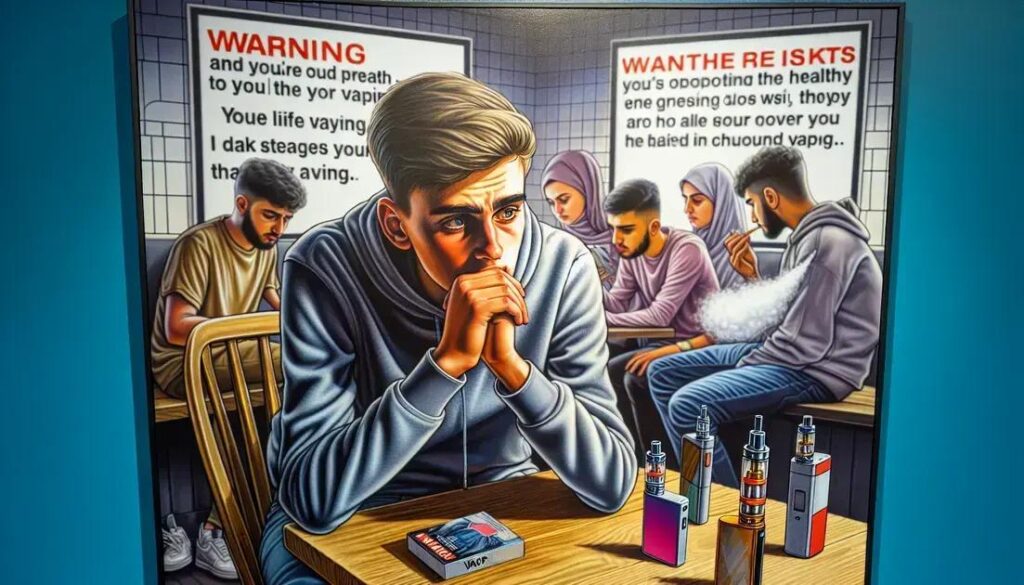Youth vaping is a serious public health concern, driven by targeted advertising and the misconception that it’s a safer alternative to smoking; long-term health consequences include nicotine addiction, respiratory problems, and potential cardiovascular issues, necessitating comprehensive prevention and intervention strategies.
Youth vaping is a growing concern for parents and communities alike. With new regulations aimed at curtailing this trend, it’s crucial to understand the implications.
Understanding the current youth vaping crisis

The rise in youth vaping is a significant public health crisis. Rates of e-cigarette use among teens have skyrocketed in recent years, raising concerns about the long-term health consequences and the addictive nature of nicotine. This increase isn’t just a trend; it’s a serious problem impacting the physical and mental well-being of young people.
Many factors contribute to this crisis. The marketing of vaping products often targets youth, using attractive flavors and social media campaigns to appeal to a younger audience. The perception that vaping is a safer alternative to smoking is also a contributing factor, despite evidence suggesting otherwise. Easy accessibility, both online and in some stores, further fuels this problem.
The consequences of youth vaping are alarming. Nicotine addiction can lead to difficulty concentrating, mood swings, and impaired brain development. Long-term health effects are still being researched, but there’s evidence suggesting links to respiratory problems and other health issues. Understanding the scope of this crisis is the first step toward finding effective solutions.
The impact of regulations on vape accessibility

New regulations aim to curb youth vaping by limiting the accessibility of vaping products. These regulations often involve raising the minimum age for purchasing vaping products, restricting the sale of flavored e-liquids, and limiting online sales. The impact of these measures varies depending on their specific design and enforcement.
Raising the minimum purchase age is intended to prevent underage vaping. However, the effectiveness depends on robust enforcement and strategies to prevent underage individuals from accessing vapes through older peers or online marketplaces. The impact of age restrictions alone may be limited without addressing other accessibility issues.
Restrictions on flavored e-liquids aim to reduce the appeal of vaping to young people, who are often drawn to sweet or fruity flavors. The success of this measure depends on the breadth of the flavor ban and the creativity of manufacturers in circumventing these restrictions. A complete ban is usually more effective than partial restrictions.
Limiting online sales seeks to reduce the anonymity and ease of access associated with purchasing vapes online. However, enforcement presents a challenge due to the global reach of the internet and the ability of sellers to operate outside regulatory oversight. Effective online monitoring and international cooperation are crucial for success in this area.
The overall impact of regulations on vape accessibility is a complex issue. While regulations can significantly reduce youth access to vaping products, their effectiveness relies heavily on strong enforcement, public awareness, and comprehensive strategies addressing various aspects of accessibility.
How advertising affects youth perceptions of vaping

Advertising plays a significant role in shaping youth perceptions of vaping. Marketing campaigns often use imagery and language associated with fun, social acceptance, and rebellion, appealing to teenagers’ desire for independence and belonging. This targeted marketing creates a positive association with vaping, downplaying or ignoring the health risks.
The use of colorful packaging, appealing flavors (like fruit or candy), and social media influencers further contribute to the normalization of vaping among young people. These tactics effectively bypass traditional anti-smoking campaigns, which often focus on the negative health consequences, a message that may not resonate as strongly with teens.
Advertising creates a false sense of safety. Many ads subtly or overtly suggest that vaping is a harmless alternative to smoking, despite the fact that vaping products still contain nicotine, a highly addictive substance. This misinformation is particularly harmful because it encourages experimentation and minimizes the long-term risks associated with nicotine addiction.
The ubiquity of vaping ads across various media platforms (online, social media, and sometimes even in physical locations) only amplifies their impact. Constant exposure to positive imagery and messaging desensitizes young people to the dangers of vaping, making it easier for them to experiment and eventually become addicted.
Regulations aimed at curbing the impact of vaping advertising are essential to protect youth. However, the effectiveness of these regulations depends on enforcement and the ability to adapt to ever-changing marketing strategies. The fight against the impact of vaping advertising on youth is an ongoing battle requiring constant vigilance and innovative counter-strategies.
Comparing vaping to traditional smoking

While both vaping and traditional smoking pose significant health risks, they differ in several key aspects. Traditional cigarettes burn tobacco, releasing thousands of chemicals, many of which are carcinogenic. Vaping, on the other hand, heats a liquid containing nicotine and flavorings, producing an aerosol.
The immediate health effects also differ. Traditional smoking leads to immediate lung damage and increased risk of respiratory infections. While vaping is not harmless, the immediate effects are less severe, although long-term effects are still being studied. The misconception that vaping is a ‘safer’ alternative is a dangerous one.
Nicotine addiction is a major concern in both. Traditional cigarettes contain high levels of nicotine, making addiction highly likely. Vaping products also contain nicotine, albeit often in varying concentrations, and can be equally addictive. Addiction to nicotine in either form can severely impact brain development in young people.
The social context also differs. Traditional smoking has historically been associated with a particular image, whereas vaping has become more normalized in some social circles, potentially making it more appealing to young people. This social perception needs to be addressed through education and awareness campaigns.
Though both are harmful, vaping’s long-term health effects are less well understood. It’s crucial to remember that ‘less harmful’ doesn’t mean harmless. Both traditional smoking and vaping significantly increase the risk of serious health problems. More research is needed to fully understand the long-term consequences of vaping.
Long-term health implications of youth vaping

The long-term health effects of youth vaping are still being researched, but emerging evidence points to significant concerns. Nicotine’s impact on brain development during adolescence is particularly worrying, potentially affecting memory, attention, and learning abilities. The developing brain is highly vulnerable to the effects of nicotine.
Respiratory problems are another major concern. Vaping can irritate the lungs and airways, leading to coughing, wheezing, and shortness of breath. Long-term vaping may increase the risk of chronic respiratory illnesses, similar to those seen in smokers, although the extent of the risk is still under investigation.
Cardiovascular health is also affected. Studies suggest a link between vaping and increased heart rate and blood pressure. Long-term vaping could contribute to the development of cardiovascular diseases, such as heart disease and stroke, although more research is needed to confirm this link definitively.
The specific chemical components in e-liquids also raise concerns. While the exact long-term effects of many of these chemicals are unknown, some are suspected to be harmful. Further research is vital to determine the cumulative health impact of these substances, especially when combined with nicotine and the potential for synergistic effects.
Finally, the addictive nature of nicotine in vaping products can have lasting consequences. Nicotine addiction can lead to lifelong dependence, making it difficult to quit and leading to further health risks associated with continued vaping.
Conteúdo não disponível
FAQ – Frequently Asked Questions about Youth Vaping
What are the immediate health effects of vaping?
While less severe than traditional smoking in the short term, vaping can still cause lung irritation, coughing, and shortness of breath. Nicotine addiction is also an immediate concern.
How does vaping affect brain development?
Nicotine in vaping products negatively impacts brain development in adolescents, potentially affecting memory, attention, and learning abilities. The developing brain is highly susceptible to nicotine’s harmful effects.
What are the long-term health risks of vaping?
Long-term risks include chronic respiratory illnesses, cardiovascular issues (like heart disease and stroke), and potential damage from various chemicals in e-liquids. More research is needed to fully understand the long-term impacts.
How does vaping advertising influence teenagers?
Vaping ads often target youth with appealing imagery, flavors, and messaging, creating a positive association that downplays or ignores health risks. This contributes to the normalization and acceptance of vaping among teenagers.
How does vaping compare to traditional smoking?
Both are harmful, but traditional cigarettes release thousands of carcinogens. Vaping heats a liquid, producing an aerosol with nicotine and flavorings. Both can cause addiction, but the long-term health impacts of vaping are still under investigation.
What can be done to address the youth vaping crisis?
A multi-faceted approach is needed, including stricter regulations on sales and marketing, comprehensive education campaigns addressing the risks of vaping, and public health initiatives targeting both youth and adults.

Gabriel de Jesus is a journalist specialized in digital media and the founder of the blog Guia da Notícia. Passionate about clear and accessible information, he launched the platform in 2016 to deliver reliable news on politics, economics, society, and culture. With a direct style and simple language, Gabriel has turned the blog into a regional reference for independent journalism.



